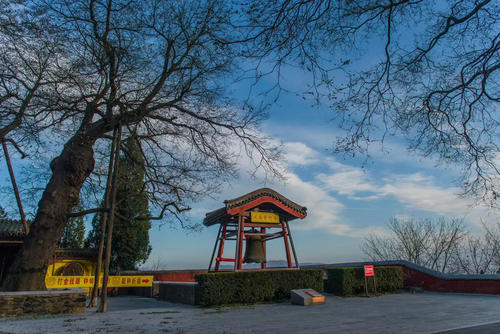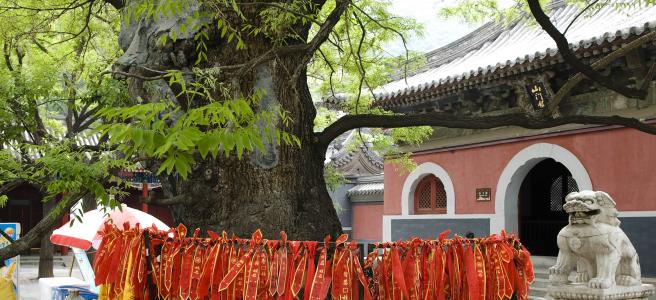Chinese Name: 戒台寺 Pronunciation: Jiè Tái Sì
Building Time: 622
Occupied Area: 44,000 square meters
Recommended Time for Visit: Half-day or one day
Popular Activities: Enjoying lilac flowers from April to May
Address: Jingkun Road, Yongding Town, Mentougou District, Beijing
Building Function: For holding Buddhism activities and learning Buddhist culture
| Tourists | Ticket Price |
| Adults | 45 yuan |
| Children (taller than 1.2 meters) | 45 yuan |
| Seniors(aged 60 or above 60) | 22 yuan |
Children younger than 6 years old or under 1.2 meters.
| Temple Gate | April to October | November to March |
| Opening Hours | 8:30-17:30 | 8:30-16:30 |

Located in Mentougou District, Beijing, the Jietai Temple was built in the fifth year (622) during the reign of Emperor Gaozu (618-626) of the Tang Dynasty (618-907), formerly known as Huiju Temple. Later, it was renamed Wanshou Temple in the Ming Dynasty (1368-1644). At the same time, because the temple served as the largest Buddhist temple to those who would like to be converted into a Buddhist (aka being initiated into monkhood), it got the present name, the Jietai Temple.
As a key cultural relics site under state protection, it is home to the largest and most complete number of preserved cultural relics of the Liao Dynasty (907-1125) in the north of China. In particular, the temple houses plenty of the rare Buddhist treasures of the Liao Dynasty such as stupas, altars, and the like.

In 622 of the Tang Dynasty, it boasted the name of “Huiju Temple” and was known as a place for the Zen master Zhizhou to withdraw from society and live in solitude.
In the Liao Dynasty, a Bodhisattva altar was added by a monk called Fajun who had spent years here. Consequently, it attracted people who aimed to be inducted into monkhood life all over the nation.
In the Yuan Dynasty (1271-1368), Yuequan, an eminent monk, lived here and rebuilt the temple, adding the Bell and Drum Towers.
During the Ming Dynasty, another rebuilding work was conducted by Master Zhihuan, giving it a new shape featuring 16 arhats, Four Heavenly Kings Palace, and so on. Besides, it was renamed Wanshou Temple this time.

In the Qing Dynasty (1636-1912), Zizhegong, a famous monk, spent more than 40 years here. Many civil organizations held activities in the temple, and other different kinds of palaces were established in the temple.
After the founding of the People’s Republic of China, the temple ceased its Buddhist activities and was managed by the Beijing Gardening and Greening Bureau and opened as a park. On October 28, 1957, the temple was listed as the first batch of cultural relics under protection in Beijing.
Since the 1980s, the temple has reopened after a major renovation and several statues have been recreated by a Beijing sculpture factory.
In 1998, the Buddhist Association of China began to send monks to the temple.

The Peony Yard, a famous scenic attraction of the temple, is a quiet and beautiful garden built in the Qing Dynasty. Many peonies are planted in the yard, and the flowers bloom every April and May, enabling the scenery to be much more elegant and beautiful. Besides flowers, the buildings in the yard are very delicate and ingenious, so you might pay a visit as well.

The Hall of One Thousand Buddha Statues was built in the Liao Dynasty and renovated in the Ming and Qing Dynasties. It was originally a three-story eave-and-pavilion-style wooden structure, 27 meters wide, 24 meters deep, and more than 30 meters high.
On the top of the door is a plaque with the four Chinese characters, which mean ‘light of wisdom’ by Emperor Qianlong (1736-1796). There is a tall bronze statue of Vairocana Buddha in the center of the hall. Brick walls on both sides are inlaid with glazed wall decorations as well as lots of niches. There is a small wooden Buddha statue with a height of 10 centimeters in each niche, totaling 1680 statues.
Emperor Qianlong, the sixth emperor of the Qing Dynasty, had visited the temple many times. There are two inscribed tablets left with his original calligraphy works. When Emperor Qianlong first visited the temple, the most famous ancient lilac was transplanted from the Old Summer Palace to add splendor to the ancient temple.
In the twenty-sixth year (1901) of the reign of Emperor Guangxu (1875-1908), the Eight-Power Allied Forces invaded Beijing, causing the capital in a great panic. Empress Dowager Cixi fled to Xi’an city with Guangxu. Those who were rich and powerful also fled there. Many people believed that the Buddha could protect them from the disaster. So many people sought shelter in the temple. At that time, the temple became a sheltered place for more than a thousand people.
Enter from the Gate Hall →the Hall of Heavenly Kings →the Mahavira Hall → the One Thousand Buddha Statues →the Peony Yard
Take bus 948, M44 and get off at Jietaisi Station.
Chinese: 请带我去戒台寺。 English: Please take me to the Jietai Temple.
If you go to the Jietai Temple from the center of Beijing (Grand Hyatt Beijing), it takes about 55 minutes (about 115 yuan).
If you go to the Jietai Temple from Beijing Capital International Airport, it takes about 1 hour and 15 minutes (about 215 yuan).
If you go to the Jietai Temple from Beijing Daxing International Airport, it takes about 1.5 hours (about 245 yuan).
If you go to the Jietai Temple from Beijing West Train Station, it takes about 40 minutes (about 80 yuan).
